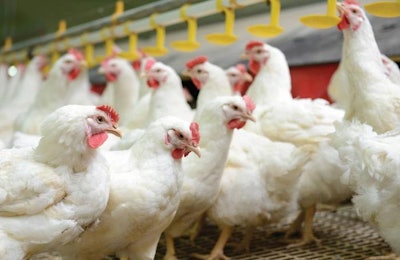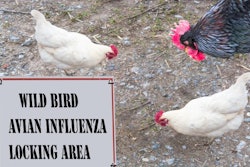
After a period of freedom from the disease, highly pathogenic avian influenza (HPAI) outbreaks in poultry have been confirmed again in China and Ghana. New cases have been also been reported in Russia, Taiwan, and Bulgaria, and the low-pathogenic disease has been detected in Danish poultry.
Already reported by the agriculture ministry last week, China has confirmed to the World Organisation for Animal Health (OIE) that the H5N1 HPAI virus variant was detected in a flock of 1,615 broilers in the Haixi Mongolian and Tibetan Autonomous Prefecture of Qinghai province in the last week of June. Around 1,000 of the birds died, and the rest have been culled. HPAI was last reported in Chinese poultry in October of 2017.
China experienced a series of HPAI outbreaks linked to the H5N6 and H7N9 viruses in March this year, according to the South China Morning Post, with one popular Hong Kong songbird garden closed for 21 days.
Taiwan’s veterinary authority has confirmed to the OIE a further two recent outbreaks of HPAI linked to the H5N2 virus. Both were on farms with meat ducks in Yunlin, bringing the county’s total outbreaks so far this year to 41. Between the two outbreaks, 400 of the birds died, and 6,207 were culled to reduce the risk of the infection spreading further.
Following four outbreaks of HPAI in poultry caused by the H5N6 variant, the Philippines’ animal health agency has declared the country free of the disease to the OIE. The most recent confirmed cases were in November last year. More than 481,000 head of poultry were lost to the disease through mortality or destruction in these four outbreaks, which were first reported in August of 2017.
Africa: HPAI returns to Ghana
Free of HPAI since November of 2016, Ghana’s agriculture ministry has confirmed to the OIE two new outbreaks of the disease linked to an H5 virus. Almost 6,000 birds died and more than 7,208 more were destroyed at two farms in the central-southern regions of Ashanti and Eastern in June. It appears that some birds were moved illegally from the farm in Ashanti with the initial outbreak to the second premises, spreading the infection further.
Local media report that a second farm in Eastern state may also have been infected. According to Starr FM Online, 2,000 birds have been culled in the last few days at a second farm in the community of Nkawkaw in Eastern region after the disease was suspected to have spread there.
Europe: 11 more outbreaks in Russian poultry
Russia’s number of HPAI outbreaks in poultry linked to an H5 virus subtype since mid-June has risen to 28, with 11 new poultry premises affected June 8-21. All the latest cases—involving a total of 2,167 birds—were confirmed in backyard flocks. Seven of the new outbreaks were in the previously affected oblasts of Samara and Penza, but Saratov and Orlov have now recorded their first cases. A suspected outbreak in the city of Livny in Oryol, which was reported by local media last week, has not been officially confirmed to the OIE.
So far, OIE has been informed that more than 487,000 Russian poultry have been lost to HPAI in the latest series of outbreaks, which began in the first week of June.
An outbreak of H5N8 HPAI at one of Bulgaria’s largest commercial poultry producers in mid-June has been confirmed to the OIE by the agriculture ministry. It involved a flock of 13,820 birds at Donchevo in the province of Dobrich. This brings the number of outbreaks since March this year to eight, with more than 72,000 poultry lost due to mortality or culling.
Low-pathogenic avian influenza viruses of an H5 subtype have been detected for a second time in Denmark as the result of a national surveillance program. Latest to be affected, according to the official report to the OIE, was a farm at Faksinge in Vordingborg municipality in Zealand (East), where there were 2,679 mallard ducks reared for restocking game, as well as 12 laying hens. All the birds have been destroyed to minimize the risk of the infection spreading, and the possibility of the virus mutating to one of high pathogenicity.
In early May, the surveillance program revealed a similar virus at a duck farm at Holstebro in the Mid-Jutland (West) region. The outbreaks are being treated as unconnected by the Danish authorities. None of the birds at either outbreak farm showed clinical symptoms.
According to the Danish Veterinary and Food Administration, 3,500 birds in Faksinge were destined for culling because of the detection of the virus. There are no commercial poultry flocks near to the outbreak. With a one-kilometer radius, hobby farmers are not required to keep their birds indoors, but they cannot move their birds or eggs for a period of 21 days.
Avian flu risks to Europe present in Africa, Middle East
Between mid-February and mid-May 2018, there were fewer cases of HPAI in wild birds in the European Union (EU) than the same period of previous years, according to a new report from the European Food Safety Authority, European Centre for Disease Prevention and Control, and European Union Reference Laboratory for Avian Influenza.
There is no evidence that the H5N6 strains circulating in the region have affected humans, and the risk to people of zoonotic transmission is assessed as low.
There were three HPAI outbreaks linked to the H5N6 virus variant, and 11 outbreaks caused by the H5N8 subtype on poultry farms over the period, as well as two outbreaks in captive birds (one H5N6, and one H5N8), and 55 events in wild birds linked to the H5N6 virus. There were also 15 outbreaks of low-pathogenic avian influenza in three EU countries.
Authors of the report warn that the HPAI situation — particularly regarding the H5N1 and H5N8 virus variants — in Africa and the Middle East should be closely monitored as uncontrolled spread of the virus increases the risk of genetic changes that could pose a risk to the health of people and/or poultry in the EU.

















